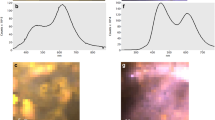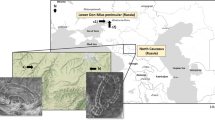Abstract
MOST clays contain a few parts per million of uranium and thorium and a few per cent of potassium, so that the body of an ancient pot receives a radiation dose of the order of 1 r./g/yr., mainly from α-particles. Some of this energy is stored in the constituent minerals of the clay either by the creation of new lattice defects or by the filling of existing impurity traps. On heating, some of this energy is emitted as visible light. In the majority of cases the pot will have been fired to about 800° C in antiquity when it was made, so that accumulation of stored energy begins anew from that time, and there is the possibility, first suggested by Daniels et al.1, that the thermoluminescent glow observed from ancient pottery could be used as a measure of its age. Thermoluminescent study, in the dating of lava flows3 and limestones2, for example, is fairly well known as a geological tool, but little has been heard of its archæological exploitation since an announcement by Kennedy and Knopff4 in 1960 and a description of technique by Houtermans, Grögler and Stauffer5 in 1960. The present communication reports the results obtained on potsherds ranging back to 8,000 years in age and widely spread in provenance.
This is a preview of subscription content, access via your institution
Access options
Subscribe to this journal
Receive 51 print issues and online access
$199.00 per year
only $3.90 per issue
Buy this article
- Purchase on Springer Link
- Instant access to full article PDF
Prices may be subject to local taxes which are calculated during checkout
Similar content being viewed by others
References
Daniels, F., Boyd, C. A., and Saunders, D. F., Science, 117, 343 (1953).
Zeller, E. J., Wray, J. L., and Daniels, F., Bull. Amer. Assoc. Pet. Geol., 41, 121 (1957).
Sabels, B. E., Symp. Radioactive Dating, Athens (Intern. Atomic Energy Agency, Vienna), 87 (1962).
Kennedy, G., and Knopff, L., Archæology, 13, 147 (1960).
Houtermans, F. G., Grögler, N., and Stauffer, H., Helv. Phys. Acta, 33, 595 (1960).
Turner, R. C., Radley, J. M., and Mayneord, W. V., Brit. J. Rad., 31, 397 (1958).
Author information
Authors and Affiliations
Rights and permissions
About this article
Cite this article
AITKEN, M., TITE, M. & REID, J. Thermoluminescent Dating of Ancient Ceramics. Nature 202, 1032–1033 (1964). https://doi.org/10.1038/2021032b0
Issue Date:
DOI: https://doi.org/10.1038/2021032b0
This article is cited by
-
Recognition of Yuan blue and white porcelain produced in Jingdezhen based on graph anomaly detection combining portable X-ray fluorescence spectrometry
Heritage Science (2024)
-
Decline of Lanna ceramic group production in northern Thailand (Ban Bo Suak site) confined by radiocarbon and luminescence dating
Archaeological and Anthropological Sciences (2022)
-
Ceramic chronology by luminescence dating: how and when it is possible to date ceramic artefacts
Archaeological and Anthropological Sciences (2020)
-
Point defects and pre-dose requirements for sensitization of the 300°C TL peak in natural quartz
Physics and Chemistry of Minerals (2009)
-
Study and progress of the thermoluminescence dating of the ancient pottery and porcelain
Science in China Series E: Technological Sciences (2009)
Comments
By submitting a comment you agree to abide by our Terms and Community Guidelines. If you find something abusive or that does not comply with our terms or guidelines please flag it as inappropriate.



